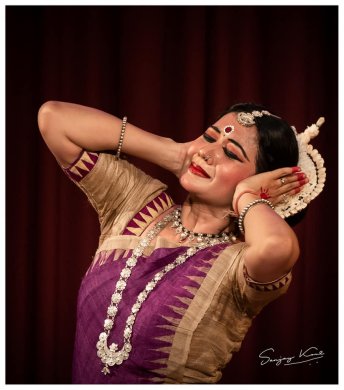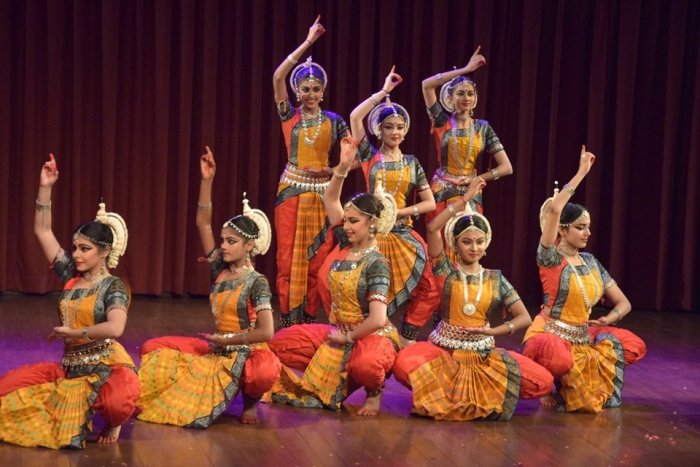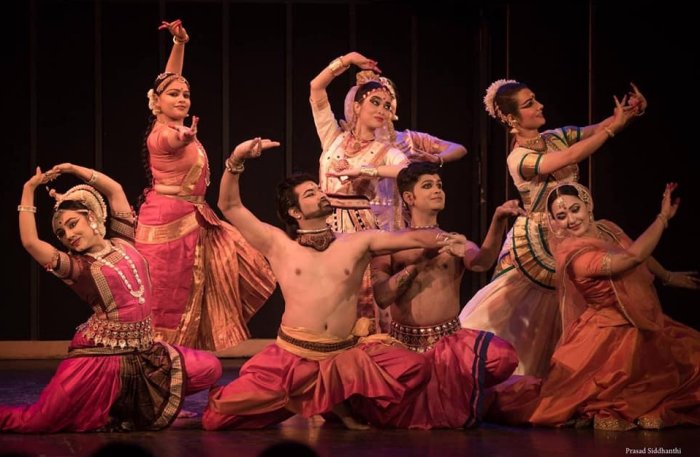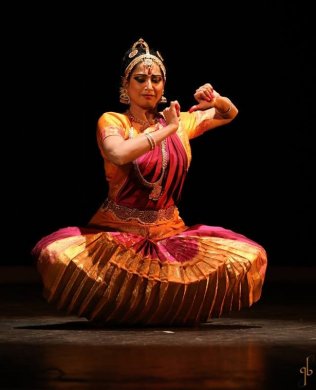
|   |

|   |
 e-mail: leelakaverivenkat@gmail.com Summer in Delhi July 4, 2019 Before the curtain comes down on the performance scene during summer with the temperature a scorching 45 degrees, many dance institutions decide to have their annual day - for school final exams are over, and there is a gap before many families begin to leave for vacations. At the Triveni, Jayaprabha Menon's International Academy of Mohiniattam students Ananya Nair, Abhirami Dileep, Ranjitha Rajesh and Reji Anoop, and finally Chhau dancers Hemant Sparsha and Sudhir Kumar performed. And wisely, offering youngsters the opportunity of watching an established performer's recital, Odissi dancer Lipsa Satpathy, a disciple of late Guru Gangadhar Pradhan, was specially invited for the occasion. Trained for Mohiniattam under Kalamandalam Saraswathy and Bharati Shivaji, Jayaprabha has also learnt Bharatanatyam under Guru C.V. Chandrasekhar and has had the benefit of guidance under Kavalam Narayana Panikkar from whom she has imbibed knowledge of Kerala's special Sopanam music. Her disciple Ananya's presentation of Ganapati Stuti "Agajamukha" from the Sopanam repertoire, in Madhyamavati ragam set to Chempada talam, in the variations round the "Nalinaayakadala" phrase (choreographed by Jayaprabha), followed by 'Govardhana Giri' in Darbari Kanada with the concluding nritta to the line "Natyarasodhara nana bharana" was neat, pointing to good training. With growing years, she is bound to evolve. Abhirami Dileep next presented technically correct Bharatanatyam starting with Alarippu in tisram followed by "Shankara Sri Giri" in Hamsanandi. The more experienced disciple Ranjitha Rajesh began with nritta through the Mukhachalam set to raga Nattai, with a change of raga towards the finish rendered to increased speed, followed by the interpretative Swati Tirunal padam "Poonthen nermozhi" in Anandabhairavi, the nayika reminiscing sadly with the sakhi, the days of love she had experienced and enjoyed with her hero Santaguna Kanthan Padmanabhan, who was now preoccupied with another. Hemant Sparsha and Sudhir Kumar, the young Mayurbhanj Chhau performers, presented Jodha in the tandav style, comprising the Hathyadhara technique of the Paika warriors preparing for battle. In conclusion was the senior disciple of Jayaprabha, Reji Anoop, who showed her professionalism presenting an abhinaya number based on Swati Tirunal's composition "Kanakamaya" wherein the nayika watching a procession, is struck by the distinguished appearance of the nayak and wonders whether she is having a vision of Kubera, or the Sun God. She mentions a host of deities before deciding that such an appearance can only belong to Padmanabha and none else. The dancer ended the evening with Sapta Jeeva.  Lipsa Satpathy (Photo: Sanjay Koul) The Odissi by Lipsa Satpathy was in the true tradition of Gangadhar Pradhan's school of professionally trained students. She started with 'Pancha Bhoota' choreographed by Aruna Mohanty. The passage on Bhumi where sinking Mother Earth is held aloft and saved providing a home for various creatures, was followed by a tribute to Water which sustains life, Jeevanam Maha Bhootam vayamyeham. The beautifully held chauka in the Agni segment, with sequences devoted to Akash and Vayu, the other cosmic elements, were all evocatively treated. The edited Nayika Bheda the dancer presented to suit a half hour slot, while mentioning all the types fleetingly, treated in some detail the Abhisarika based on Ramahari's singing of "Sakhi gomoro kunjaku aaja." (setting off to the green bower for a tryst with the loved one). "Jahlampata Natawara" portrayed the angry jilted and deceived khandita, and finally the swaadheenapatika showed the supremely ecstatic nayika in combined shyness and happiness in the song "Neela he nidhi." Lipsa's persuasive abhinaya showed her as a complete dancer.  Students of Ranjana Gauhar (Photo: Joginder Dogra) It was the turn of Ranjana Gauhar's institution Utsav a week later with a large group of junior students taking part in Su-Tarang 2019. Beginning with Mangalacharan set to raga Yaman in Ektali, Pancha deva Stuti, designed for youngsters with homage to Ganesh, Narayan, Rudra, Surya and finally Saraswati, the Goddess presiding over arts and learning in the Manikkaveena verse set to Mohanam with hastas like Suci, Padmakosha, Sarpashirsha held by the little ones and the concluding Trikhandi pranam. Group discipline and neat costumes characterized the item, with very very young bodies manfully coming to grips with the three bend posture where each part comprising head, torso and hip and lower limbs, is deflected in opposing sides to create a tribhangi posture. This requires a fluidity without jerks and watching the young bodies not doing badly at all was encouraging. The Shankarabharanam Pallavi was next and was followed by Batu. Then came the Krishna /Radha Raas Lila in ektali "Dekhigo Radha Madhav Chali" in Misra Kafi and there is reference to the Chapa Khelanti and the Bada Danda. All this is so much part of Odisha's culture. The Gaud Pallavi in ektali, a composition of Guru Mayadhar Raut under whom Ranjana was trained, was followed by "Jaya Ma" offering prayers to Goddess Durga with Dasha Mahavidya Devi Shodashi invoked with Moksha as the conclusion. The stage preparations and presentation were supervised by senior disciples Kevin Vinod Bachhan and Vrinda Chadha.  Utsav Music's World Dance Day (Photo: Prasad Siddhanthi) Celebrating the occasion of the International Dance Day, Utsav Music, the organization of impresario Churchill Pandian, presented at Habitat's Stein auditorium, several dancers in a program featuring many dance forms. That the idea of so many forms in small segments presented by so many dancers was a hit was evident from the over packed Stein auditorium, with many eager to-be- viewers turned back due to lack of space. This was a rare happening for an evening of classical dance, where one has to woo audiences. It was a good idea to start with Maitreem Bajata sung so evocatively by M.S. Subbulakshmi - for the idea of the world as one family is the aim of these dance celebrations erasing the boundaries between dancers of various denominations, in the larger effort endorsing cultivating friendships. The curtain raiser had Purvadhanashree's grace in the Kalyani Jatiswaram presentation in the Vilasini Natyam style of the Andhra devadasi. Next was the fine Kathak rendition bringing out the joy of movement in teentaal nritta by Divya Goswami. The following Odissi segment saw Ardhanariswara presented by Kevin Bachhan and Vrinda Chadha, disciples of Ranjana Gauhar, based on Shankaracharya's poetry 'Ganga Taranga' sung as a ragamalika. While the stree / purusha contrasts with Parvati draped in Mandaara Mala and Shiva in his garland of skulls was well brought out, for this critic the parts portrayed with the two dancers close together were more indicative of the half male half female form of Ardhanari than when they danced in separated spaces. One of the finest couples of the evening Rakesh Saibabu and Priya Srinivasan presented a Chhau / Bharatanatyam interaction based on excellent understanding, husband and wife with fine stage presence combining very well. After the Nagendra Haraya trilochanaya interpretation, the lingodbhava mudra held with his hand in shikhara mudra placed over her open palm was very communicative in showing the oneness among two forces. Then came the keertanam with the dancers making a fine twosome -"Ananda nadamidum Padam" with the line "tattaimozhi Shivagami manaalan" (the Lord wedded to the sweet tongued Shivagami) rendered with finesse. Bharati Shivaji's Russian disciple Alexandra Vodopyanova gave a start to her Mohiniattam presentation with Mukhachalam in Suratti. The penultimate segment of the evening featured Jhilmil Pathak, a Sattriya disciple of Guru Bhabananda Borbayan. After the haribol and Sri Krishnaya namah chant was the prayer to "Vasudevaya Devaki Nandanaya, nanda roopa Govindaya Namoh Namah" salutation to the Krishnam vande Jagatgurum which was followed by the Sutradhari item with its series of epithets applying to Krishna - "Kripaanga, Upaanga, Rupaanga…" The finale was Tarangam ("Bala Gopala Krishna") in Kuchipudi by students of Raja / Radha / Kaushalya Reddy - three females and one male dancer. The three girls exuded a sense of joy from start to end with the signature line of Narayana Tirtha's Krishna Lila Tarangini - "Nitya Narayana…." The male dancer technically correct kept a very serious demeanor. A little more of the relaxed ease in dancing is needed, bringing out the sheer enjoyment of movement, provided one is not depicting a special mood of tension. Bold try requires more polish The evening was called 'Her Stories'. Conceived and choreographed by Bharatanatyam teacher/dancer Kanaka Sudhakar and her daughter/disciple Aparajita Sarma, the innovative evening presented by Aparajita pertained to stories of characters from myth - the situation in each case being relevant to women in society today.  Aparajita Sarma Photo: Balatchandirane Govindasamy After opening with Mayur Alarippu, the dancer presented one of the newly conceived episodes 'Kashmakash' built round the dilemma of Kaikeyi caught between two attitudes of her love and respect for Rama against her ambitions of seeing her son Bharata ascend the Ayodhya throne - with of course the situation having been created by Mandara's prompting. Vacillating in her mind, Kaikeyi is on the one hand serene, loving and appreciative of Rama's nobility. But almost at once, her fears are stirred by Manthara of becoming reduced to being a vassal of Kausalya who can lord it over her with Rama becoming king. Intelligently stringing the mental conditions, to two different laya gaits, with small nritta punctuations added, the narrative still was too fast to register in details with the audience. This, despite Aparajita's good grasp over technique and nritta with ability to emote too. There is an optimum time one needs to give for images to get fully communicated. One main drawback felt right through by this critic was the very poor sound balancing making sahitya inaudible in places - despite a crew of fine musicians led by Kanaka Sudhakar's nattuvangam with Venkateshwaran's vocal support, Tanjavur Kesavan on mridangam, flute by Rajat Prasanna and violin by Chembai Srinivasan. I felt that for a new effort of this nature, enough rehearsing with the musicians had not taken place. Sahitya put into too many ragas can also be very distracting. Like in Kathakali, pinning two different attitudes to rendition in two ragas would perhaps make for a better buildup of contradictions. Perhaps reworking this to see how the main mood does not get muffled in the narration - is needed. The Draupadi-Sathyabhama Samvad is also an interesting case of opposites - for Draupadi here as the obedient wife of five princes tells Sathyabhama who is highly conscious of her status and beauty and place in Krishna's affections (despite this, unable to accept Krishna's closeness to Rukmini) about how she manages her varied husbands with such success and without creating tensions among them. But the long lecture about bathing, eating, sleeping only after the husband's comforts are all satisfied (whichever one she happens to be staying with at the moment), about waiting for and on each of them, keeping aside vanity and desire, restraining jealousy, renouncing everything and doing penance when the husband is away (!) personally seeing to the food, drink and needs, and thinking that no God in the world can equal the husband - and a great deal more to similar effect becomes difficult to hear in the times we live in. What woman of today would accept these stifling needs to abnegate one's own comforts? Aparajita when asked said that she deliberately chose this exchange to bring out the status of woman in a patriarchal society. But by showing it this way, are you making clear your disapproval of such a totally supine position for the wife? The last was a Meera Bhajan and even while Meera forsakes her aristocratic linage to become one with Krishna, she does so with no regrets. This merged into the Tillana in Desh as the conclusion. Appreciating the drive and courage to do new work and explore themes, I think Aparajita should continue. But more close exchanges with the musicians in terms of both planning and execution, are needed. Such compositions evolve over a period of time.  Writing on the dance scene for the last forty years, Leela Venkataraman's incisive comments on performances of all dance forms, participation in dance discussions both in India and abroad, and as a regular contributor to Hindu Friday Review, journals like Sruti and Nartanam, makes her voice respected for its balanced critiquing. She is the author of several books like Indian Classical dance: Tradition in Transition, Classical Dance in India and Indian Classical dance: The Renaissance and Beyond. Post your comments Please provide your name and email id when you use the Anonymous profile in the blog to post a comment. All appropriate comments posted with name & email id in the blog will also be featured in the site. |